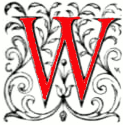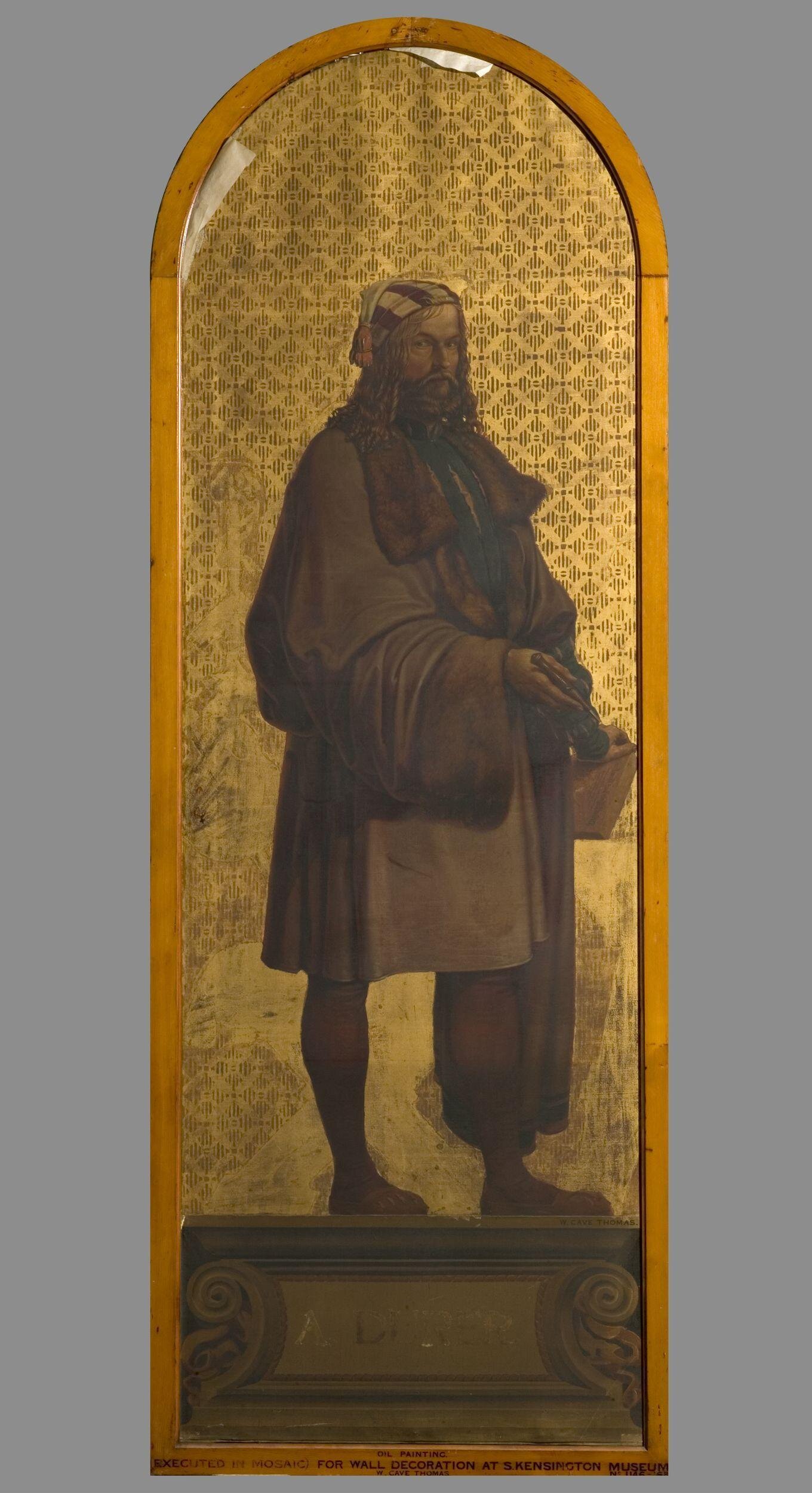
illiam Cave Thomas was born in London on 8 May 1820, the eldest son of William Claxton Thomas, a picture frame maker and guilder. His mother Ann Cave was descended from Edward Cave, the original proprietor of The Gentleman's Magazine and a friend to Dr. Samuel Johnson. Cave Thomas (as he was commonly known) was educated at University School and College before considering engineering as a profession. He spent eighteen months as an understudy to William Hosking F.S.A., Professor of Architecture at King's College, London, before deciding upon a career in the Fine Arts. He was admitted to the Royal Academy Schools in 1838, initially primarily focusing upon sculpture. At the R.A. Schools he drew and modelled for two years and also attended classes in human anatomy at the Windmill Street Medical School.
In July 1840, Thomas travelled to Munich, in the hopes of learning fresco painting from the Nazarenes. There he met with Julius Schnorr von Carolsfeld and Peter von Cornelius, who, impressed with the young artist's drawings and designs, admitted him to the Munich Academy of Art. He became good friends with the artist Heinrich Maria von Hess who allowed him to practice at the Basilica of St. Boniface's Abbey. Hess was painting a series of frescoes there and this experience allowed Thomas to master the technicalities of fresco painting. Returning to England in the spring of 1842, he entered two cartoons into the competition to find suitable designs for mural decorations for the new Houses of Parliament. Both of his cartoons were exhibited in Westminster Hall in 1843, and St Augustine Preaching to the Saxons won a premium of £100. For a later competition at Westminster, he was awarded two further prizes of £400 for his cartoons of Justice and Philosophy. Despite these early successes, a promised commission from the Mercer's Company in Cheapside to paint three altarpieces was suddenly cancelled, forcing him to temporarily abandon mural painting. He later designed decorations for the International Exhibition held at South Kensington in London in 1862, including a design symbolizing Chemistry for the exterior of the exhibition space.
Thomas first exhibited at the Royal Academy in 1843 and continued to exhibit there until 1862. He exhibited at the British Institution from 1857 to 1866. He also exhibited at the Institute of Painters in Water Colours (The New Water Colour Society) and the National Institution of Fine Arts at the Portland Gallery. In 1850 he exhibited three works at the Suffolk Fine Arts Association. Prince Albert purchased two of his watercolours, including Ecce Homo, a powerful depiction of the head of Christ, which was exhibited at the International Exhibition of 1871 and later reproduced as an autotype.
Thomas continued to exhibit in London until 1884. In addition to being a muralist, painter, and sculptor, he was also an etcher and designed book illustrations. A wood engraving of 1851 by John Thompson, after a drawing by Thomas for Oliver Goldsmith's The Traveller, published by the Art Union of London, is in the collection of the Victoria and Albert Museum. He also contributed an illustration to Isaac Watts's Divine and Moral Songs for Children published in 1867 and illustrations for the periodical London Society. His subjects for paintings included genre, literary, allegorical, and religious subjects.
His time was being increasingly devoted to other ventures, including a trip to St Petersburg on the eve of the Crimean War. His return to London signalled a return to mural painting. In 1865 he painted the heads of the twelve Apostles in circular panels for the recently constructed Russian Embassy chapel in Welbeck Street. In 1866 he received a commission to paint a large altarpiece for Christ Church, Marylebone, entitled The Diffusion of Gifts. He also was one of the artists asked design a mosaic for the South Kensington Museum, for the so-called "Kensington Valhalla," a series of thirty-five mosaics depicting artists. Cave Thomas produced a design for the figure of Albrecht Dürer, although the mosaic was never executed. This was an appropriate subject for Cave Thomas considering the prominent Germanic influences upon his art.

Cover of Thomas's book on mural decoration, from a copy in the Internet Archive.
Thomas also published many treatises upon art and other subjects and was a frequent contributor to contemporary periodicals such as The Builder. His major publications include: Mural or monumental decoration: its aims and methods in 1869; Symmetrical Education or the Importance of Just Proportion in Mind and Body in 1873; The Revised Theory of Light: The Principles of the Harmony of Colour in 1875; and Cosmic Ethics: Or the Mathematical Theory of Evolution Showing the Full Import of the Doctrine of the Mean, and Containing the Principia of the Science of Proportion in 1896.

Albert Dürer: design for a mosaic in the Museum (the 'Kensington Valhalla'), c. 1868. © Victoria and Albert Museum, London.
Other ventures that Thomas was associated with included plans that he submitted to the Royal Commission, with the intention to establish a Grand Central College of Science and Art with the surplus funds generated by the Great Exhibition of 1851. Both Thomas and his lifelong friend Ford Madox Brown were involved with the North London School for Drawing and Modelling located in Mary's Terrace, Camden Town, which was initiated in 1850 by their friend Thomas Seddon. Its purpose was to instruct tradesmen engaged in masonry, carving, plastering, cabinetmaking, and the casting and chasing of metals "in the true knowledge of form" (Surtees 70). Thomas served as its first superintendent and as its Drawing and Modelling Master. In 1852, however, he "resigned in despair of ever getting his salary" and was replaced by Madox Brown (Hueffer 90). Thomas became a much-valued instructor at the Working Men's College. He was also involved in the founding of the National Rifle Association and in 1859 he joined the Artists Rifles [38th Middlesex Artists' Rifle Volunteer Corps].
In the early 1850s Cave Thomas maintained a studio in a backroom on the ground floor of 72 Newman Street whilst living at 80 Newman Street. Later addresses included 23 Holles Street and then 6 Wells Street in the 1860s. Having never married, in later years he lived with his sister and their widowed mother, along with two servants. In 1871 he was living at 203 Camden Road in the parish of St. Pancras, London. In the census for 1891 he was described as a "Historical Painter" and was lodging at 8 Fitzroy Street, St. Pancras. Ten years later he is recorded as a boarder at 115 Bedford Hill, Streatham. He died in Wandsworth in 1906, at the age of 86.
Bibliography
Bénézit, Emmanuel. Dictionary of Artists, Vol. 13. Oxford: Oxford University Press, 2006. 884-885.
Codell, Julie F. "William Cave Thomas: Pre-Raphaelite Defector or Educator." The Journal of Pre-Raphaelite Studies VIII (May 1987): 25-40.
Dafforne, James. "British Artists: Their Style and Character. No. LXXXIV – William Cave Thomas." The Art Journal New Series VIII (1869): 217-219.
Hueffer, Ford Madox. Ford Madox Brown. A Record of his Life and Work. London: Longmans, Green and Co., 1896.
Surtees, Virginia Ed. The Diary of Ford Madox Brown. London and New Haven: Yale University Press, 1981.
Tupper, John Lucas. "English Artists of the Present Day. XXX. – William Cave Thomas." The Portfolio II (1871): 149-53.
Created 1 February 2024